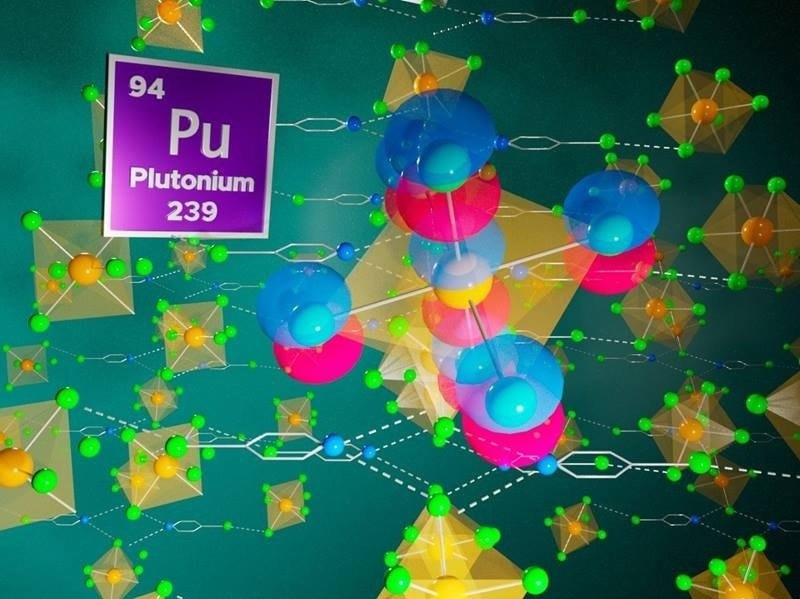Comprehending the electrons’ arrangement in compounds with actinide elements, like plutonium and uranium, can aid in progressing the development of next-generation nuclear materials. These elements are difficult to analyze owing to their complicated chemistry and radioactivity.
 Researchers probed the characteristics of plutonium-ligand bonds using a combination of experimental and computational data. Image Credit: Nathan Johnson, Pacific Northwest National Laboratory
Researchers probed the characteristics of plutonium-ligand bonds using a combination of experimental and computational data. Image Credit: Nathan Johnson, Pacific Northwest National Laboratory
Scientists synthesized five varied hybrid materials with a particular compound subunit of chlorine and plutonium: the [PuCl6]2—anion. They probed the electronic structure of anion and discovered that when the electrons in the plutonium-chlorine bonds were mostly not shared (ionic), they also exhibited key contributions from covalent bonds where the electrons are shared.
Such covalent bonds are associated with the 5f shell of the quantum-mechanical model of the atom. Also, this shell is the area of mismatch between the observations of scientists and theories of how electrons are arranged around atomic nuclei.
The Impact
The study’s findings aid researchers in forecasting and comprehending the physical and chemical behavior of transuranic elements—which are elements beyond uranium in the periodic table. This is a key step toward progressing the development of next-generation nuclear materials.
It can also aid in managing nuclear waste more efficiently. By achieving new data on the role of the 5f shell in plutonium-chlorine bonds, this study contributes to the combined aim of addressing the f-electron challenge. Solving this is the all-encompassing aim of the Heavy Element Chemistry Program of the Department of Energy Office of Science.
Summary
Five varied hybrid materials were synthesized by scientists: (4XPyH)2[PuCl6], where X= H, Cl, Br, I, and (4IPyH)4[PuCl6]·2Cl, from an acidic, chloride-rich aqueous media. The research group comprised scientists from the Pacific Northwest National Laboratory (PNNL), George Washington University, the University of São Paulo, and the State University of New York at Buffalo.
Then, the team probed the electronic structure of the [PuCl6]2—anion with the quantum theory of atoms in molecules and natural localized molecular orbital analysis. The scientists defined the fundamental bond mechanism and hybrid atomic orbital contributions inside the plutonium-ligand bonds.
They also assessed two associated compounds that they had reported in earlier papers. They subjected materials, comprising the [PuO2Cl4]2− and [PuCl3(H2O)5] molecular units, to a similar level of examination to demonstrate trends in bonding.
The findings showed the Pu-Cl bonds were mostly ionic and still exhibited significant covalent contributions that amplified as bond polarity reduced from [PuCl3(H2O)5] < [PuO2Cl4]2− < [PuCl6]2−. Likewise, the Pu-based hybrid atomic orbitals in the Pu–Cl bonds featured decreased s and d orbital character, where the f orbital contribution is amplified.
Nevertheless, the Cl-based hybrid atomic orbitals did not differ very much. This implies that the 5f shell adds up to the Pu–Cl bond’s covalent character. This level of examination offered useful knowledge of the coordination geometry, oxidation state role, and metal-ion charge in plutonium–ligand bond analysis.
The main source of funding for this research is the Department of Energy Office of Science, Basic Energy Sciences program, Division of Chemical Sciences, Geosciences, and Biosciences, Heavy Element Chemistry program at PNNL and GWU. The researchers also acknowledge support from the National Technical Nuclear Forensic Center and the São Paulo Research Foundation (FAPESP).
The High-Performance Computing Cluster operated by Research Technology Services at George Washington University, the National Laboratory for Scientific Computing (LNCC/MCTI, Brazil, SDumont supercomputer), and the Center for Computational Research at the University at Buffalo offered the computational resources.
Journal Reference:
Surbella, R. G., et al. (2022). Plutonium Hybrid Materials: A Platform to Explore Assembly and Metal–Ligand Bonding. Inorganic Chemistry. doi.org/10.1021/acs.inorgchem.2c02084.